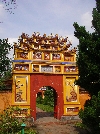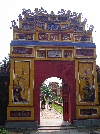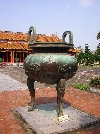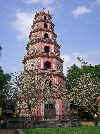|
|
 |
| |
|
| |
 Photo
essay: Photo
essay:
Vietnam Bicycle Tour: Imperial Roots (Central)
|
| |
|
Hue (20km,
12mi). After an overnight train we disembark in Hue and take a bicycle tour of the city – a city of history.
Points of interest: Old capital of Vietnam from 1802-1945 (Unesco
World Heritage Sites), Citadel, Imperial Palace, Thien Mu Pagoda, Sake Factory,
Tu Duc Tomb.
|
 |
| |

|
Trackside at Hue train station. The
architecture not as distinctive as some rail stations in the world. |
 |
| |

|
Nifty dinner are served on the train.
The compartment has soft bunks and is air-conditioned. On our trip you
could set your watch by the departure and the arrival was only a couple minutes
late. |
|
| |
 |
Hue straddles the Perfume River.
The picture on the left looks north across the river towards the Citadel.
A lot of the south bank (new town side) in the center of town is a park with
non-motorized promenades. One of the features of the riverside park is a
sculpture garden (right). |
 |
| |

|
 More roof
tops of Hue. More roof
tops of Hue. |
 |
| |
 |
Another attraction on the river --
for tourist at least -- is boat rides (right). There were dozens of wide
air-conditioned boats scattered along the river waiting for tourists with touts
on shore trying to sell the trips. Capacity seems to exceed demand. |
 |
| |

|
The old walled city is called the
Citadel. The Viet Cong held the Citadel for 27 days after Tet, in 1968.
Within the Citadel is the Imperial Palace. Once it was forbidden for most
commoners to enter, but now it is open for tours. |
 |
| |
 |
The Forbidden Purple Palace once had
over 100 buildings and palaces. It got its name because the concubines painted
the harem purple. Separate walkways and gates for military, King and mandarins.
Has the palaces for the emperor’s personal use, a completely isolated world from
which commoners were forbidden. The emperor sat in his elevated throne for
official receptions and important court ceremonies. |
 |
| |

 |


Temple roof detail, gates and urn. |
 |
| |

|
Two-wheel-only bridges across the
Perfume River. Of course we have a bias to bicycle-only bridges.
These two are halfway there -- banning cars, trucks
and buses -- but motorcycles are allowed |
 |
| |
 |
Thien Mu Pagoda. The irony of
such a lovely meditative place is it is where the Buddhist monk
Thich Quang Duc
 set
out from, in 1963, when he drove to Saigon to immolate
himself in protest to the treatment of Buddhist by the then government.
The car was brought back is on exhibition at the monastery. set
out from, in 1963, when he drove to Saigon to immolate
himself in protest to the treatment of Buddhist by the then government.
The car was brought back is on exhibition at the monastery. |
 |
| |

|
Thien Mu Pagoda bell (left). Turtle
with commemorative stele on its back, with the history of the temple and important monks (right). |
 |
| |

|
The largest temple had several
ornate alters, statues for ancestors and a large area for prayer and
meditation. |
 |
| |

|
Around the grounds were lawns,
paths, planted beds and a smaller pagoda (left.) Behind the main temple is
a patio of bonsai potted trees (right) -- a bonsai garden. Some of the
dwarf trees looked like they were hundreds of years old. |
 |
| |

|
A monk using a weed-whacker to trim
the grass. I thought a lot about this image and keep thinking that there
must be a more spiritual / in-harmony-with-nature way to do the task, but in the
end all that needs to be accomplished is to keep the grass at bay and the
weed-whacker serves the purpose. |
|
| |

|
An incense maker demonstrates her craft and then
encourages visitors to buy some to the product. Actually, her daughter
gives the hardest sell. |
 |
| |

|
The tomb of Emperor Tu Duc was constructed from
1864-1987 and served as a second imperial city where the emperor, who reigned
from 1848-1883, came for relief from national and household concerns. The
emperor's contemplative nature and poetic spirit was reflected in the landscape
and arrangement of the 50 buildings.. The tomb complex is divided into two main
areas: the ritual and the burial. The tombs of Empress Le Thien Anh and
Emperor Kien Pulc, who briefly ruled in 1884, are also located inside the wall
of the cmplex. |
|
| |

|
Xung Khiem Pavalion is still perched on the edge of
the lake. |
 |
| |

|
This is part of a complex of
buildings described as the ritual or worshiping area. This is where the
Emperor would spend time during his visits. In addition to still having shrines
and alter, parts of it has now been converted into a performance space and
souvenir shop. |
 |
| |

|
Stele pavilion is part of the burial
area of the Tuc Duc tomb complex. This area is said to represent the after
life. The environment and buildings mirror the mundane world. |
 |
| |

|
Statues of an elephant and horse,
and warriors, in the honor court in the burial area of the Tuc
Duc Tomb. The mandarins await orders. |
 |
| |

|
Empress Le Thien Anh tomb |
 |
| |

|
Wall enclosing Empress's sepulture
(right). |
|
| |

|
Typical of visitors, this family was lining up for a family photo.
Most of the visitors we saw at this site were Vietnamese, but it might have only
been because we and they were ahead of the tourist buses. |
|
| |
|
| |

 |
|
    |
|
|
 |
 Please
contact us if you would like to be added to
Ibike's mailing list or have questions, comments, corrections or criticism. (Also, please let us know how you learned about us and
found this site.) Privacy policy. Please
contact us if you would like to be added to
Ibike's mailing list or have questions, comments, corrections or criticism. (Also, please let us know how you learned about us and
found this site.) Privacy policy.
 IBF Homepage
IBF Homepage  Ibike Programs
Ibike Programs
 Ibike Schedule
Ibike Schedule
 Search
Search
"Hosted by
DreamHost - earth friendly web hosting"
Created by David Mozer
Copyright ©1993-2022 Ibike LLC. All rights reserved.
|

 Photo
essay:
Photo
essay: 








 set
out from, in 1963, when he drove to Saigon to immolate
himself in protest to the treatment of Buddhist by the then government.
The car was brought back is on exhibition at the monastery.
set
out from, in 1963, when he drove to Saigon to immolate
himself in protest to the treatment of Buddhist by the then government.
The car was brought back is on exhibition at the monastery.
 Please
contact us if you would like to be added to
Ibike's mailing list or have questions, comments, corrections or criticism. (Also, please let us know how you learned about us and
found this site.) Privacy policy.
Please
contact us if you would like to be added to
Ibike's mailing list or have questions, comments, corrections or criticism. (Also, please let us know how you learned about us and
found this site.) Privacy policy.![]() IBF Homepage
IBF Homepage ![]() Ibike Programs
Ibike Programs
![]() Ibike Schedule
Ibike Schedule
![]() Search
Search



